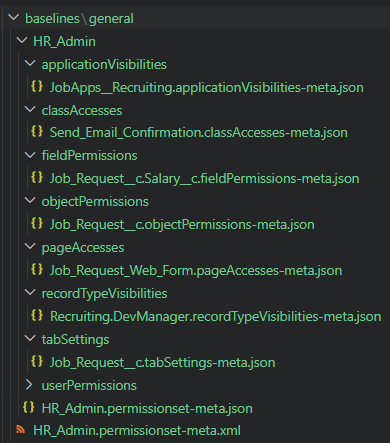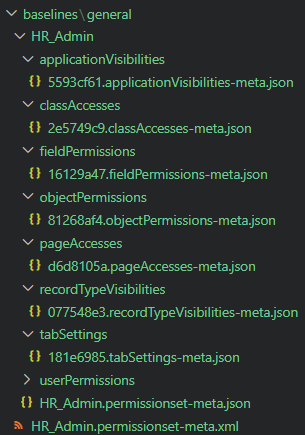A JavaScript package to disassemble then transform XML files into smaller JSON files. This is an extension of my XML Disassembler package.
Large XML files can be a pain to mantain in version control. These files can contain thousands of lines and it becomes very difficult to track changes made to these files in a standard version control server like GitHub.
This package offers a way to break down large XML files into smaller JSON files which can be used to review changes in a format easier to digest. When needed, the inverse class will reassemble the original XML file from the smaller JSON files.
This will parse and retain the following XML elements:
- CDATA sections (
"![CDATA[") - Comments (
"!---") - Attributes (
"@__**")
Install the package using NPM:
npm install xml2json-disassembler
/*
FLAGS
- filePath: Relative path to 1 XML file or a directory of XML files to disassemble, then transform into JSON files. If the path provided is a directory, only the files in the immediate directory will be disassembled and transformed.
- uniqueIdElements: (Optional) Comma-separated list of unique and required ID elements used to name disassembled files for nested elements.
Defaults to SHA-256 hash if unique ID elements are undefined or not found.
- prePurge: (Optional) Boolean value. If set to true, purge pre-existing transformed directories prior to disassembling and transformed the file.
Defaults to false.
- postPurge: (Optional) Boolean value. If set to true, purge the original XML file after transforming it into smaller JSON files.
Defaults to false.
- ignorePath: (Optional) Path to an ignore file containing XML files to ignore during disassembly. See "Ignore File" section.
*/
import { XmlToJsonDisassembler } from "xml2json-disassembler";
const handler = new XmlToJsonDisassembler();
await handler.disassemble({
filePath: "test/baselines/general",
uniqueIdElements:
"application,apexClass,name,externalDataSource,flow,object,apexPage,recordType,tab,field",
prePurge: true,
postPurge: true,
ignorePath: ".xmldisassemblerignore",
});Disassemble then transform 1 or multiple XML files into JSON files. Paths provided must be relative paths. If the filePath is a directory, only the XMLs in the immediate directory will be processed. Each XML wiill be transformed into JSON files in new sub-directories using the XML's base name (everything before the first period in the file-name).
Example:
An XML file (HR_Admin.permissionset-meta.xml) with the following nested and leaf elements
<?xml version="1.0" encoding="UTF-8"?>
<PermissionSet xmlns="http://soap.sforce.com/2006/04/metadata">
<applicationVisibilities>
<application>JobApps__Recruiting</application>
<visible>true</visible>
</applicationVisibilities>
<classAccesses>
<apexClass>Send_Email_Confirmation</apexClass>
<enabled>true</enabled>
</classAccesses>
<fieldPermissions>
<editable>true</editable>
<field>Job_Request__c.Salary__c</field>
<readable>true</readable>
</fieldPermissions>
<description>Grants all rights needed for an HR administrator to manage employees.</description>
<label>HR Administration</label>
<userLicense>Salesforce</userLicense>
<objectPermissions>
<allowCreate>true</allowCreate>
<allowDelete>true</allowDelete>
<allowEdit>true</allowEdit>
<allowRead>true</allowRead>
<viewAllRecords>true</viewAllRecords>
<modifyAllRecords>true</modifyAllRecords>
<object>Job_Request__c</object>
</objectPermissions>
<pageAccesses>
<apexPage>Job_Request_Web_Form</apexPage>
<enabled>true</enabled>
</pageAccesses>
<recordTypeVisibilities>
<recordType>Recruiting.DevManager</recordType>
<visible>true</visible>
</recordTypeVisibilities>
<tabSettings>
<tab>Job_Request__c</tab>
<visibility>Available</visibility>
</tabSettings>
<userPermissions>
<enabled>true</enabled>
<name>APIEnabled</name>
</userPermissions>
</PermissionSet>will be disassembled into a sub-directory named HR_Admin as such:
- Each nested element (
<recordTypeVisibilities>,<applicationVisibilities>,pageAccesses, etc.) will be disassembled into further sub-directories by the nested element name. If a unique & required ID element (applicationis the unique ID element for<applicationVisibilities>) is found, the disassembled file will be named using it. Otherwise, the disassembled files for nested elements will be named using the SHA-256 of the element contents. - Each leaf element (
<description>,<label>,<userLicense>) will be disassembled into the same file in the first sub-directory, which will have the same file-name as the original file.
/*
FLAGS
- filePath: Relative path to the directory containing the JSON files to reassemble into 1 XML file (must be a directory).
- fileExtension: (Optional) Desired file extension for the final XML (default: `.xml`).
- postPurge: (Optional) Boolean value. If set to true, purge the disassembled directory containing JSON files after the XML is reassembled.
Defaults to false.
*/
import { JsonToXmlReassembler } from "xml2json-disassembler";
const handler = new JsonToXmlReassembler();
await handler.reassemble({
filePath: "test/baselines/HR_Admin",
fileExtension: "permissionset-meta.xml",
postPurge: true,
});Reassemble all of the JSON files in a directory into 1 XML file. Path provided must be relative path. Note: You should only be reassembling JSON files created by the XmlToJsonDisassembler class for intended results. The reassembled XML file will be created in the parent directory of filePath and will overwrite the original file used to create the original disassembled directories, if it still exists and the fileExtension flag matches the original file extension.
If you wish, you can create an ignore file to have the disassembler ignore specific XMLs similar to a .gitignore file.
The disassembler uses the node-ignore package to parse ignore files that follow .gitignore spec 2.22.1.
By default, the XML disassembler will look for an ignore file named .xmldisassemblerignore in the current working directory. Set the ignorePath flag to override this ignore path when running the XmlToJsonDisassembler class.
By default, the package will not print any debugging statements to the console. Any error or debugging statements will be added to a log file, disassemble.log, created in the same directory you are running this package in. This file will be created when running the package in all cases, even if there are no errors. I recommend adding disassemble.log to your .gitignore file.
This log will include the results of this package and the XML Disassembler package.
The logger's default state is to only log errors to disassemble.log. Check this file for ERROR statements that will look like:
[2024-03-30T14:28:37.950] [ERROR] default - The XML file HR_Admin.no-nested-elements.xml only has leaf elements. This file will not be disassembled.
[2024-04-16T14:55:27.170] [ERROR] default - The file path C:\Users\matthew.carvin\Documents\xml2json-disassembler\test\baselines\not-an-xml.txt is not an XML file.
To add additional debugging statements to the log file, import the setLogLevel function from the package and run the function with debug to print all debugging statements to a log file.
When the log level is set to debug, the log file will contain statements like this to indicate which files were processed for disassembly and reassembly:
[2024-04-16T14:56:29.665] [DEBUG] default - Parsing file to disassemble: C:\Users\matthew.carvin\Documents\xml2json-disassembler\test\baselines\general\attributes.xml
[2024-04-16T14:56:29.675] [DEBUG] default - Created disassembled file: C:\Users\matthew.carvin\Documents\xml2json-disassembler\test\baselines\general\attributes\nest\103c6c8b.nest-meta.xml
[2024-04-16T14:56:29.676] [DEBUG] default - Created disassembled file: C:\Users\matthew.carvin\Documents\xml2json-disassembler\test\baselines\general\attributes\nest\f876f2be.nest-meta.xml
[2024-04-16T14:56:29.682] [DEBUG] default - test\baselines\general\attributes\nest\103c6c8b.nest-meta.xml has been transformed into test\baselines\general\attributes\nest\103c6c8b.nest-meta.json
[2024-04-16T14:56:29.687] [DEBUG] default - test\baselines\general\attributes\nest\f876f2be.nest-meta.xml has been transformed into test\baselines\general\attributes\nest\f876f2be.nest-meta.json
import {
XmlToJsonDisassembler,
JsonToXmlReassembler,
setLogLevel,
} from "xml2json-disassembler";
setLogLevel("debug");
const disassembleHandler = new XmlToJsonDisassembler();
await disassembleHandler.disassemble({
filePath: "test/baselines/general",
uniqueIdElements:
"application,apexClass,name,externalDataSource,flow,object,apexPage,recordType,tab,field",
prePurge: true,
postPurge: true,
});
const reassembleHandler = new JsonToXmlReassembler();
await reassembleHandler.reassemble({
filePath: "test/baselines/HR_Admin",
fileExtension: "permissionset-meta.xml",
postPurge: true,
});This project was created from a template provided by Allan Oricil.
His original license remains in this project.



